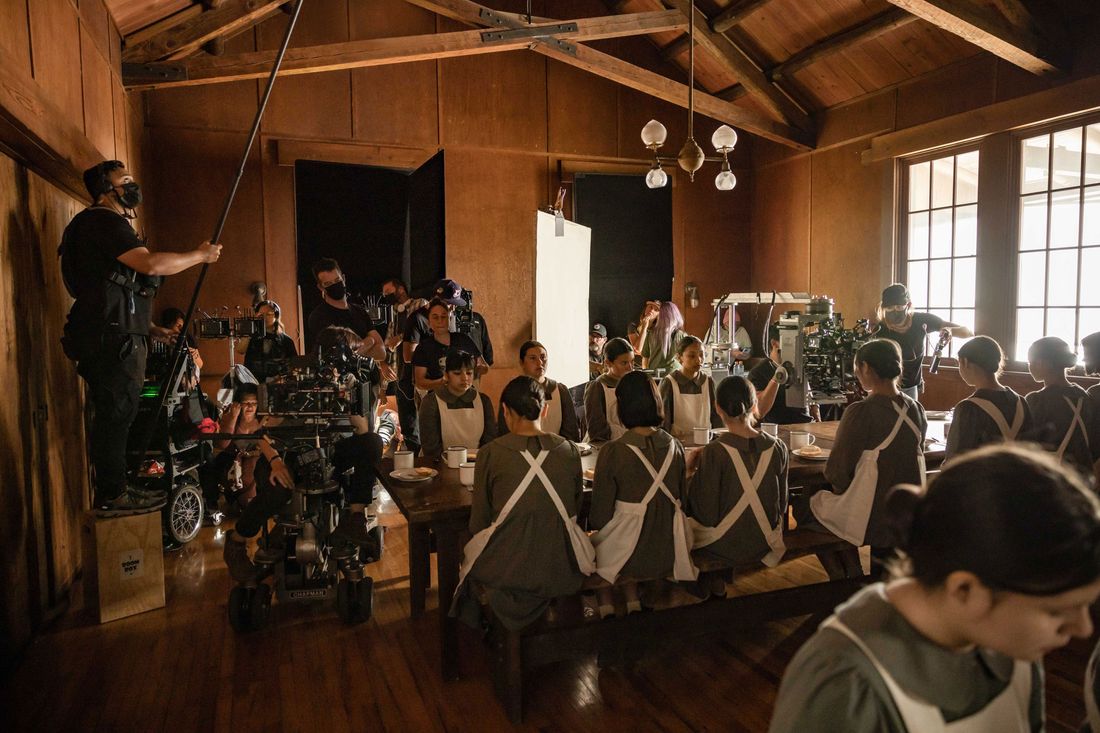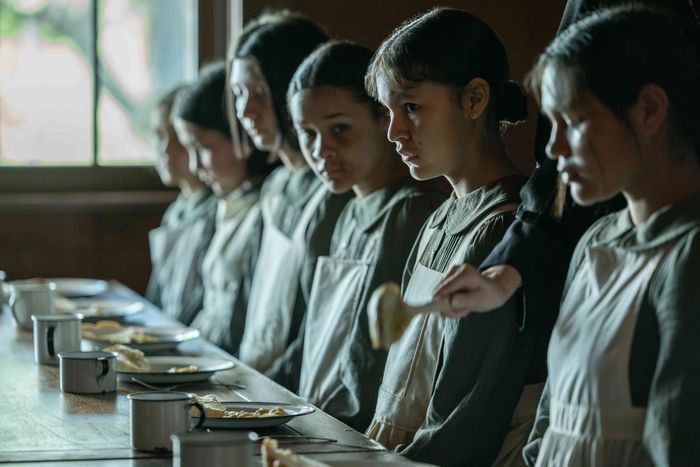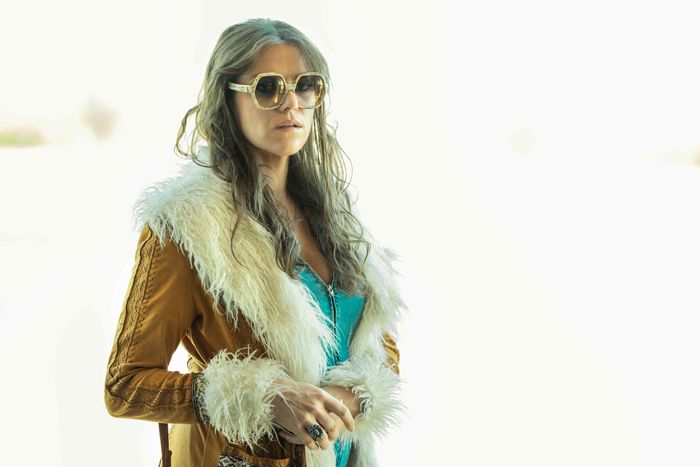
Most series billed as comedies don’t open an episode with a character cleaning blood off a knife in a convenience store restroom, or a montage of unsettling images: a child running through the woods at night, an old man eating at a kitchen table, a zoom toward a closed door. But most comedies aren’t Reservation Dogs, Sterlin Harjo’s acclaimed series about reservation life in the 21st century. As the FX show has unfolded across three seasons, it’s grown comfortable taking big and occasionally wild swings, confident its viewers will sit with an episode’s obscured meaning until the series clarifies it on its own timetable, in its own unique way.
As supervised and sometimes personally directed by Harjo, Reservation Dogs’ style runs the gamut from loose, improvisatory, hangin’-out indie to stylized sequences that take the characters into dreams, hallucinations, and a skeptical, almost cockeyed view of America’s official self-image. There are critiques and reclamations of American film genres that previously treated Native Americans as bit players, villains, or symbols, and it all fits together somehow, perhaps because the show spends less time struggling to justify its various departures than in devising and executing them. Harjo assembled a killer lineup of Native directors for his most plum assignments, including Danis Goulet, an independent filmmaker who absorbs, mixes, and applies disparate film genres in a way that fits into the gestalt of Reservation Dogs while also making her episodes stand apart.
Goulet’s most recent, “Deer Lady,” is a multilayered, time-shifting, flashback-filled tale mostly presented through the visual grammar of a 1970s horror film, somewhere between grindhouse and arthouse. We eventually learn the blood-scrubbing Deer Lady (Kaniehtiio Horn) was kidnapped as a child and imprisoned at a boarding school, where she escaped via the surrounding, fog-choked forests and later sought revenge for her ordeal. More than any of her other episodes, Goulet says “Deer Lady” illustrates “what I appreciate most about Rez Dogs: It’s willing to really take risks.”
“Deer Lady” is very intense stuff and a bit of a stylistic break from the rest of the series.
Episode three is a real departure from the tone of the series. It’s talking about a collective historical trauma. Sterlin wrote that episode, and it’s really incredible, the way he brings us into this history through a much-loved character that we had seen before, the Deer Lady, who is this magnetic and mysterious person.
A lot of the episode has the feeling of a horror movie and a Holocaust movie.
The topic of boarding schools is not widely known in the public consciousness of America, but it is something that is so important to talk about because this is about the foundation of the country. When you think about warfare, it’s possible people know about the Indian wars, but it is so, so insidious to go after children as an act of warfare as well, to take them away from their families. And then for those places to be places of abuse — I mean, there were experiments done on children in these schools. Many of them died in the schools. When I spoke to our consultant who wrote an incredible book about boarding schools, she said to me, “Whatever you show onscreen will not be as bad as it was in real life.” It’s really chilling. Anyone who’s Indigenous is very familiar with this history. This is not new to any of us. But reading it as it was presented in the script, I felt like, “This is a horror show.” It made sense to put it in that sort of container. But I was also hoping that a genre bent would help people come into it a little more easily, because it is a very tough topic to digest.
What can you tell me about the way the episode alternates its present-day scenes, which are very much in the established ’90s indie-film style, and the more formally rigorous stuff in the flashbacks?
Right from the get-go, this episode has a different tone. It stands alone. There is some humor and lightness in the mischievousness of the Deer Lady and the playful conversations she’s having in the diner with Bear. But there isn’t a lot of the usual release you get from the humor and jokes of people around the community. Bear’s really off by himself in that episode, and so tonally, it lives in its own space. But when you’re talking about a topic that has this much gravity, that is this dark, it feels like in order to do it justice, it makes sense to have a departure.
All the historical parts of the story have to have a separation so that it’s a different universe, a different feeling. I love that Sterlin framed all this as the Deer Lady’s origin story, because she is a fantastical character. There are supernatural elements to her. That gives us a freedom that a story like this might not otherwise have. Once we went into the boarding school, we imagined this ’70s horror-film aesthetic: superlong zoom lenses and a sense of foreboding and dread. We looked at the reboot of Suspiria as a touchpoint because it was set in a dance school, but also because it had that shadowy, foreboding feeling, an eeriness to everything.
Is there a style bible for the show? Are there certain things you can or cannot do?
No. There’s an established visual language, but Sterlin gives everyone an enormous amount of freedom.
There’s a moment in the episode where the boy in the school says, “They can’t stop us from smiling.” How would you relate that back to the series as a whole?
This series is about the balance of light and dark. When you look back in cinema history, we’ve been misrepresented onscreen for over 100 years. For a long time, Native filmmakers have been advocating for the chance to get our turn to tell our story, to show the world what we could be, and to show what life is really like. Reservation Dogs is groundbreaking because it doesn’t show Indigenous people in the ways we’ve seen them in the past, as stereotypes or dead bodies or silly, diminished characters. It has complex characters. But it’s not about victimhood. It is about love and community and family, and the way you not just survive but also thrive in the face of enormous challenges. I love that the line you quoted was written into the script, because I think our humor, along with the love that exists in our communities, is the core the show always returns to.
That the series has that real knucklehead humor that can then pivot and basically become a little horror movie is unusual, to say the least.
Sterlin has dared to do a lot with this show. I think the third episode will be a surprise to certain people. There are some tough things. Even the depiction of a child’s hair being cut in the opening scenes — people may not understand the gravity of what it is to cut hair. In Indigenous cultures, hair has profound meaning for some. You only cut your hair if you’re in mourning. That scene in particular was very difficult for the cast and crew. I think they only could have tackled that scene and that episode having been together as a part of this community for that many years before. What Sterlin’s doing is not just questioning and pushing back against the history of misrepresentation, but he’s also asking questions about process, because Hollywood didn’t just misrepresent us, they also exploited our communities in the process of filmmaking. What we try to do as Indigenous creatives is not continue that legacy of exploitation, but honor the community and give people agency.
What sorts of conversations did you have about staging that moment, as far as, “Do we actually cut somebody’s hair, or do we create a wig?”
That question took weeks to answer, because it’s an act that you have to do with so much humility. We asked so many questions. We tested wigs. We had the casting director, Loren Waters, go in with the background performers, and she was amazing for being so willing to have those tough conversations with the community. To not further exploit our communities in the name of putting things onscreen means that our people have to have agency in the process, no matter what their role is. I also called my friend and other filmmakers — including Tasha Hubbard and her son, who has long hair — to have a very in-depth conversation about what it would mean to depict this onscreen.
Where did you eventually settle on the issue?
We were so lucky to have found a young man named Adam who was planning to cut his hair anyway. He and his family decided that he would be willing to do it for the show. I can’t tell you how emotional it was for all of us to be part of something like that where someone is daring to go there, knowing that this might be a triggering process for them. Normally the show is so funny when you’re on set. You’re killing yourself laughing, people are sharing memes. But that day was really tough. And when we shot that scene you could hear a pin drop in the room. Everybody knew the gravity of what that was. It was incredibly emotional, and I just can’t say enough about the courage of everybody to go through that together, and for Sterlin as the leader of the show to be really guiding that process and walking around outside, talking to all the background performers, their families, to the work Loren was doing, to the elder who stood up in the dining room and spoke about his own experiences in the boarding school.
This is what the show does. It is carving a new path forward, not just about how we’re portrayed onscreen, but also how we actually endeavor to make things about our collective trauma and all of our humanity.
The escape sequence in the woods, with a nun in pursuit — what can you tell me about the filming of it? What were you going for, and how did you go about it?
We shot that sequence early in the process. It was really drawing on horror-movie aesthetics. We filled the forest full of smoke tubes in order to create that graphic element of thick, thick atmosphere. That’s also a moment where she escapes and the nun is looking for her and suddenly there’s a magical character who appears. We wanted that moment to feel fantastical — in spite of her fear of being chased in the woods, she suddenly stumbles upon something that would be a wonder for anyone to behold. And then, of course, we have the nun being found dead later. One of the crew shared two images afterwards. One was an image of the nun on the tree, and the second was an image of a painting of somebody splayed over a piece of wood with two people surrounding them. It was an old, historical painting, but you could see a similarity.
The moment where Deer Lady stabs the man at the table is intense. It’s obscene but also liberating somehow.
I just can’t say enough about what Kaniehtiio Horn brought to this episode, the thousands of shades she can find in any given moment. In the diner, there’s this dynamic where she’s the cat and Bear’s the mouse and she’s playing with him the whole time. It’s a delight to watch because she has that playfulness, but this also takes her character to a very different place, such a vulnerable place. When she shows up on the doorstep, we suddenly see a different side of her, and she almost is back to being a child in a way. When she knocks on the door, she is not that powerful, supernatural badass that she goes around as in the world.
We always knew we would be shooting this wide horror-type zoom. I almost thought I would do it as a one-shot take, in the zoom. But we also shot this classic horror movie creep up to the back of the man at the table, where we never really get a close look at his face. Even though she is the deadly killer, we were reversing that, to depict the idea that she was actually the one who was terrified in that moment — that there was a monster in the room and she was walking in to face it.
Why did you play part of it in tight closeups of your lead actress instead of sticking to the notion of doing it all in one wider shot?
There was so much happening in her eyes. It was disturbing, it was everything. When we saw her do the close-ups, we just couldn’t believe what was there in her performance. And then comes that moment after, where she goes out onto the steps after it’s all done. She walks away and goes from the shattered person to a place where we’re starting to see shades of a liberation that comes with knowing that, as brutal as this all is, maybe there is some sort of justice here, and that she is now free to be in the world, in a different way. The change in her face, and what she was able to do — I got the shivers on set.
In your season-two episode, “Mabel,” which chronicles the death of Elora’s grandmother, you have a lot of almost painting-like shots mixed in with the handheld stuff. There’s an overhead shot of a pot on a stove and at the beginning, the bed scene where everybody is gathered around. What’s the thinking behind these shots?
For me, that episode was all about feeling that the community had come together. But it was so important that the comings and goings felt organic, and also that we were planted very staunchly with Elora and tried to stay in her point of view. It was shot incredibly subjectively, except when it came to the wide shots, and especially in the room where Mabel is dying. I almost envisioned the tableaus of old paintings of someone surrounding someone dying where the person in the middle is lit up, and then you’ve got people arranged around them. Mark Schwartzbard, the cinematographer, and I talked about some of those shots in the room itself, and trying to make it have that kind of feeling.
Also, some of my past films have drawn on social-realist aesthetics, and so I was bringing that hyper-subjectivity to this episode as well. At times we plant the camera on Elora’s shoulder and just go with her, especially in key moments. Even in larger collective moments in that episode, where we would normally position the wide shot, the camera stays within a three-foot vicinity of Elora herself, so it always feels like we’re very tight with what she’s experiencing.
I wondered about that. It seemed like you made sure that if she’s just a sliver in the frame, and not really the main focus for the viewer, you at least see part of her head from the back.
I remember a conversation I had with the camera operators on the first day where Mark said “Okay, Danis, explain the subjectivity thing to these guys who are just getting started.” And I said “Imagine that Elora is the sun and that everything rotates around her.”
Is that why there’s so much sunlight and so many colors on the yellow-gold spectrum in the episode?
Yeah. I felt like this house had this feeling of warmth in spite of Elora’s difficulty. There are many things that tip off that it wasn’t an easy relationship with her grandmother, but there’s something about that house that presents it as this warm space the community comes into. It tells you that, in spite of the conflicts she’s having with her friends, when a moment like that happens, they will show up for her. In our traditional spaces, whether they’re lodges or teepees, there’s an atmosphere that feels very warm because they’re often made of a kind of translucent hide and they cast a certain glow.
There’s a stereotype of Native men that depicts them as stoic, cryptic, and flat. Reservation Dogs goes 180 degrees in the opposite direction; one of the funniest things I’ve seen on TV is that conversation in “Run,” the second episode of season two, between Gary Farmer and Wes Studi. Their characters are offering a prayer by the water, and they use it as an opportunity to re-fight past grudges. It’s like an Abbott and Costello routine!
[Laughs.] Oh my God, I love that scene so much. One of the challenges in our communities is that because of the trauma and the difficulties and hardships that our communities have been through, people feel a lot of pressure to depict something that is wholly positive. But that pressure is a shame because it restricts a kind of artistic freedom that is afforded to everybody else. And I love that Sterlin is willing to put complex, flawed characters in there — and also to sort of poke the sacred cow, if you will. A prayer is supposed to be something that is so serious, and to bring humor or petty grudges into moments like that is so human.
How does the performance of Gary Farmer as Uncle Brownie fit into the sense of humor?
Gary Farmer is a legend in our communities. He’s been around as an actor for many decades, so he’s seen it all. He was around in the days where they were still casting non-Native people to play Native roles. I can’t imagine the stories of the sets that he’s been on. His performance subverts the earnest idea that your uncles are gonna be the ones that give you the after-school-special chat. Like, he is not that uncle, you know?
Another example of how the series throws a curveball every other week: In episode one of this season, Dallas Goldtooth gets 90 solid seconds at the beginning to hold forth and have the screen to himself.
Dallas Goldtooth is a tremendous joy to work with. We can barely get through the takes, we’re laughing so hard. He often goes off-script and comes up with all kinds of crazy lines to say. You almost want to take up your whole day doing all of the Spirit material because it’s so much fun to shoot. But that opening, yeah: The character brilliantly subverts a trope of the mystical, spiritual Indian that we’ve seen throughout cinema history. Dallas turned it into this funny, sometimes ridiculous character. In some ways when we come into season three, it’s almost like he’s the host of the show.
This interview has been edited and condensed for clarity.







